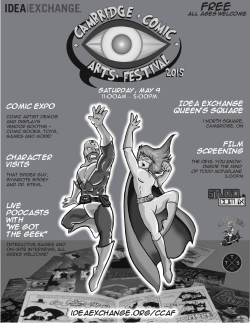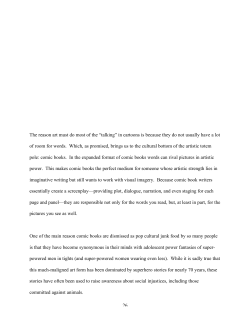
The way we were . . . May 1970 protests
The way we were . . . This is the first of what we hope to be a series by alumni sharing their most memorable anecdotes from their days at CU. Student experiences may be unique to a particular era in time, but are universal to, as George Norlin said, “all who come into and go forth from her halls, who are touched by her influence and who carry on her spirit. Wherever you go, the university goes with you.” If you’d like to share a significant CU memory, please send a maximum of 400 good words to Pam Penfold, Koenig Alumni Center, Boulder CO 80309-0459, or pam.penfold@colorado.edu. Vietnam and civil injustice made all kinds of students angry in the 1970s. 10 Coloradan December 2007 May 1970 protests By Pam Penfold On May 7, 1970, I joined what was estimated to be somewhere between 6,000 and 10,000 students on the Norlin Quad. Think about the numbers. It was, as they say today, awesome. We weren’t all long-haired veteran protesters. We weren’t all black and Chicano civil rights activists. Many of us were middle class, white and not by nature likely to join protest movements or show up for political events. Sure, we were well aware of the many campus protests — S.I. Hayakawa and his opponents created an ugly scene in Macky in March 1969, but I’d listened to it on the radio in my apartment. Antiwar moratoriums, sit-ins and marches were frequent occurrences, which I followed with interest but not involvement. The draft did make things personal as many of my friends frantically worked out ways to avoid a year-long visit to Vietnam. One friend drank massive amounts of Coca-Cola to exacerbate his ulcer in hopes of obtaining the magical 4F classification — physically unable to fight. My brother and another friend joined the National Guard, figuring six years of one weekend a month was better than 12 months in distant, dangerous jungles. But then Tricky Dick Nixon sent U.S. troops into Cambodia. Protests led to deaths in Jackson, Miss., and at Kent State in Ohio. The images were hard to bear. It was time to get involved. We were mad. So thousands descended on the Quad and called a strike to close the university down. Beyond the speeches and typical politicking, the most memorable aspect of the day was the anger and the commitment to ending the war. A frat guy I barely knew and who’d never impressed me much was a changed person. He was willing to go on strike in hopes of helping force Nixon and the Establishment to shut down the war. If he missed his finals, he’d miss the grades he needed for med school (and the draft deferment that went with it). He was willing to give up his future to stop the war. I never heard what happened to him. The university didn’t close down, but many sympathetic professors made finals optional. I turned in one paper and graduated but, like many others, didn’t attend commencement. The war didn’t end for five more long years — May of 1975. I still cry when I see the 57,939 names on the Vietnam War Memorial. And I’m still proud of those in my generation who worked so hard to end the war, foster civil rights and create the environmental movement. It was an amazing time to be a college student. Pam Penfold (Hist’70) is editor of the Coloradan and is grateful Hans Bjordahl worked for her during his student days. makes us the way we are The Great Comics War of 1991 By Hans Bjordahl My CU experience of the late ’80s and early ’90s was very much marked by the news of the day. The big local stories were the evolution of the Halloween Mall Crawl from “fun” to “scary fun” to just plain “scary,” a surge in campus activism marked by such events as the anti-apartheid “shantytown” built at the UMC fountain, and a football team that started generating wins on the field and controversy off it. The biggest event of the era, however, was in a much wider context: The Gulf War (now known as “The First Iraq War”) disrupted the usual rhythm of campus life with a rapid-fire burst of “everything else stops” news events: the invasion of Kuwait, the U.S. buildup in Saudi Arabia, the start of the air war, the start of the ground war, the quick conclusion. My filter on all these events was a public one: a comic strip I penned for the Colorado Daily called “Where the Buffalo Roam.” For reasons I can only ascribe to cosmic coincidence or perhaps a problem with the drinking water, the Daily hosted a whole gaggle of vibrant local comic strips during that time, including Holley Irvine’s “Ozone Patrol,” Tom Oling’s “Tripp” and Terry Krueger’s “SOS.” While discussing the war one night, an idea struck us: Why not play out our own version in the theater of the comics page? The Daily was willing to give it a go, and the following week readers opened their papers to discover that the characters from “WTBR” had staged an incursion across the borders to invade “Ozone Patrol” and occupy its coveted space atop the Daily’s comics page. “Tripp” and “SOS” soon formed a coalition to drive “WTBR” from its newly conquered territory. Like wars are prone to do, this one quickly escalated. We had been given permission to spoof (and supplant) the other Daily comics page mainstays (“Doonesbury,” “Sylvia,” etc.). By the end of the two-week conflict missiles were flying across the comics page. Considerable carnage ensued. Among the collateral damage: Willy from “Willy and Ethel.” What can I tell you? War is hell. The series struck such a chord that I still occasionally hear about it when running across a CU grad from the era (though perhaps that’s because it is, tragically, newly relevant). The Great Comics War was in my view a “uniquely CU” kind of event: the kind of creative experiment that could only have happened in that place, at that moment, with those artists, inspired by those events, in a newspaper where the staff literally let us walk in and draw on the comics page layouts the night before they went to press. Try that at USA Today. Hans Bjordahl (Jour’91) is a group manager at MSNBC.com and still posts the occasional comic to www.bugbash.net. Due to an apparent case of Stockholm Syndrome incurred during the Great Comics War, Hans and Holley Irvine are now married and living in Seattle. Hans Bjordahl and his cartoon colleagues at the Colorado Daily conducted their own “war” in reaction to the Gulf War in 1991. Hans is at left in 1997 while on campus making a film based on “Where the Buffalo Roam.” December 2007 Coloradan 11
© Copyright 2025





















